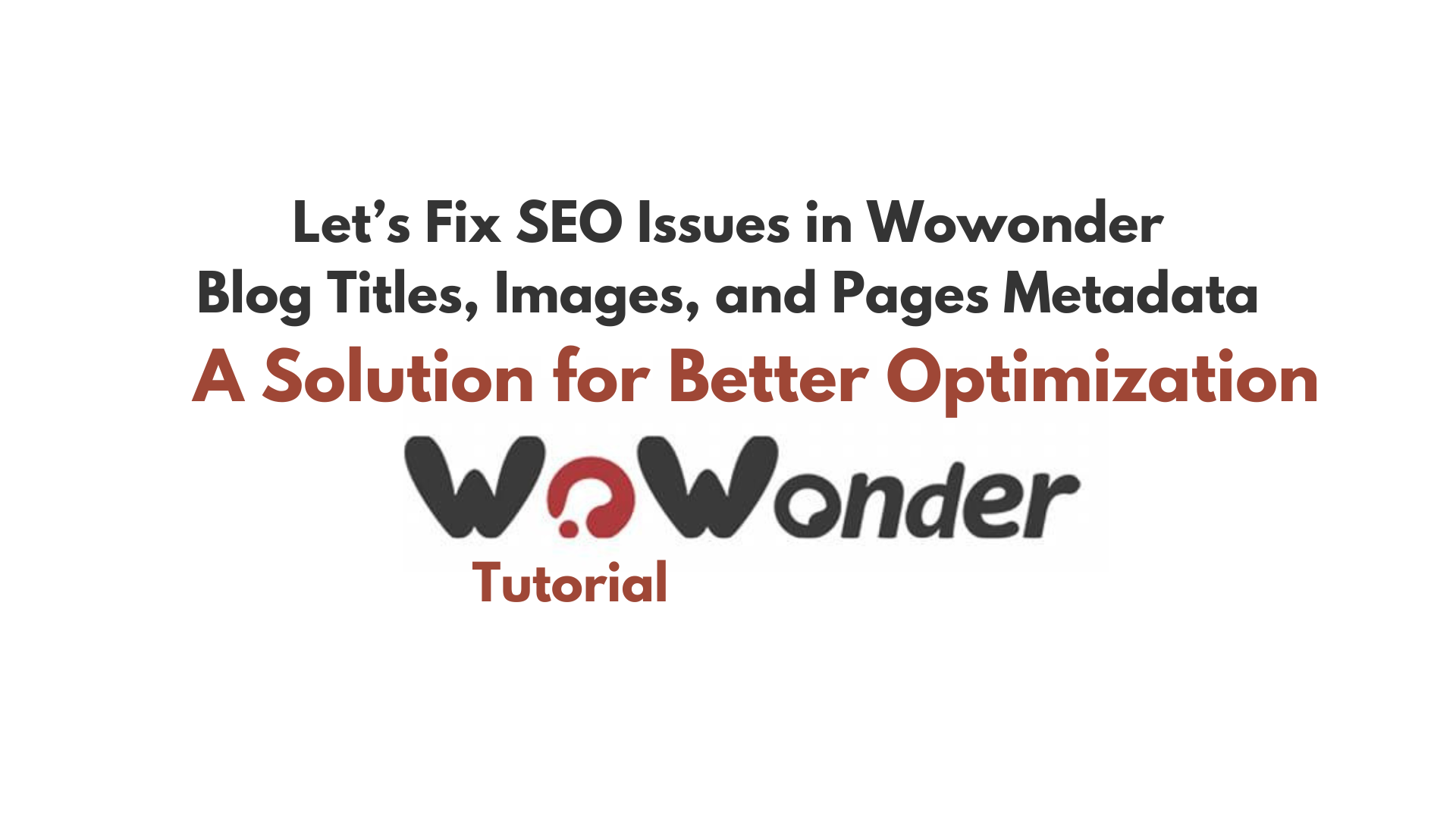Let’s Fix SEO Issues in Wowonder Blogs and Pages Metadata

Let’s Fix SEO Issues in Wowonder Blogs and Pages Metadata
If you're running a Wowonder-based social network, you may have noticed some SEO challenges that can hurt your site's visibility and ranking on search engines. Among the most critical issues are improper use of blog titles, missing alt text for images, and the lack of unique metadata for individual pages. These factors can negatively impact your site's search engine optimization (SEO) and prevent you from fully harnessing the power of search engines to drive traffic to your platform.
In this blog post, I will discuss these SEO issues in Wowonder and how they can be fixed. Additionally, I’ll walk you through the steps to resolve these issues and enhance the SEO of your Wowonder site.
SEO Challenges in Wowonder
-
Blog Titles as H2 Tags In Wowonder, blog titles are currently set as
<h2>tags, which isn’t ideal for SEO. The title of a blog post is one of the most important elements for search engines to understand the topic and content of your page. Typically, blog titles should be wrapped in an<h1>tag to signal to search engines that this is the main heading of the page. Having the blog title as an<h2>tag instead could confuse search engines and make it harder for them to rank your content effectively. -
Images with Missing ALT Text Images play a significant role in SEO, not only for user engagement but also for search engines to understand the content of your site. However, in Wowonder, images are often inserted without alt text. Alt text (alternative text) helps search engines understand the context of an image, especially if it’s visually impaired users or crawlers trying to index the content. Without alt text, your images are essentially invisible to search engines, which can affect the overall ranking of your page.
-
Duplicate Metadata for All Pages Another major SEO issue with Wowonder is that all pages are using the same
siteTitle,siteDescription, andsiteKeywordsfrom thewo_configtable. This means every page on your site (whether it’s the homepage, blog page, or a custom page) has identical metadata, which can severely limit your SEO performance. Search engines rely on unique metadata to understand the purpose and relevance of each page, so having the same metadata across multiple pages can result in poor rankings and missed opportunities for optimization.
How to Solve These SEO Issues
In my upcoming tutorial, I will guide you through the steps to address these SEO challenges. You’ll learn how to:
- Properly set blog titles as
<h1>tags for better content hierarchy and SEO optimization. - Add alt text to images to improve accessibility and search engine visibility.
- Implement unique metadata for each page on your site, ensuring that each page is properly indexed by search engines.
These simple but powerful changes will significantly improve your site's SEO and help it rank better in search engine results, driving more traffic to your platform.
If you’re ready to take control of your Wowonder site's SEO, follow along with the detailed, step-by-step tutorial I’m about to share.
In the next section, we will dive into each of these issues and provide the necessary code and guidance to implement these SEO improvements effectively. By the end of the tutorial, you’ll have a fully optimized Wowonder site ready to perform better in search engines!
Lets Start by fixing the blog read page. Here we will also be looking for any img with alt tags.
Open your /themes/wowonder/layout/blog/read-blog.phtml
Look for
<h2 itemprop="headline"><?php echo $wo['article']['title']?></h2>
and change to
<h1 itemprop="headline"><?php echo $wo['article']['title']?></h1>
Look for
<img src="<?php echo($wo['article']['thumbnail']); ?>">
and change to
<img src="<?php echo($wo['article']['thumbnail']); ?>" alt="<?php echo $wo['article']['title']?>">
Look for (Notice alt is empty here, search engines doesn't like that.)
<img alt="" src="<?php echo $wo['article']['author']['avatar']?>">
and change to
<img alt="<?php echo $wo['article']['author']['name']?>" src="<?php echo $wo['article']['author']['avatar']?>">
That is all for the blog read page
Now lets edit the other pages meta
you will need to create language key for each of this step assuming that you know how to add language in wowonder admin already, if you don't let me know and I will help.
I will do the Marketplace as example and from here you can do to all other relevant files
open /sources/products.php
Look for
$wo['description'] = $wo['config']['siteDesc'];
$wo['keywords'] = $wo['config']['siteKeywords'];
$wo['page'] = 'products';
$wo['title'] = $wo['lang']['latest_products'];
$wo['content'] = Wo_LoadPage('products/content');
and replace the
$wo['config']['siteDesc'];
$wo['config']['siteKeywords'];
$wo['lang']['latest_products'];
with
$wo['lang']['products_seo_title'];
$wo['lang']['products_seo_description'];
$wo['lang']['products_seo_keywords'];
For instance, mine looks like this.
$wo['title'] = $wo['lang']['products_seo_title'];
$wo['description'] = $wo['lang']['products_seo_description'];
$wo['keywords'] = $wo['lang']['products_seo_keywords'];
Save and visit you site product page to see the result, check your view-source.
I hope this little hack helps you rank yur site better. Enjoy:)


- Seo
- WOWonder
- Sngine
- Marketing
- Frameworks
- Film
- Fitness
- Food
- Games
- Gardening
- Health
- Home
- Literature
- Music
- Networking
- Other
- Party
- Religion
- Shopping
- Sports
- Theater
- Wellness


